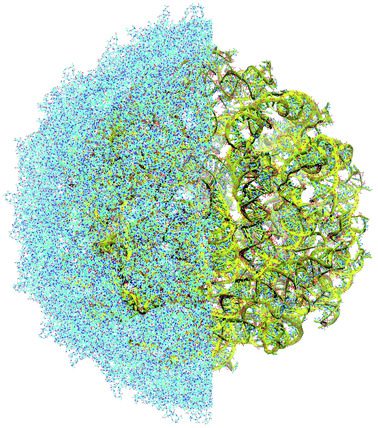Aston University scientists have made a groundbreaking discovery in the field of virology. They were able to create a 3D model of the virus with its entire genome after successfully reconstructing and validating an entire virus model using mixed-resolution cryo-electron microscopy density. The findings of the research published in Faraday Discussions provide significant implications for understanding how viruses work and developing new treatments and vaccines. This is a substantial advancement in the field of virology and could lead to a better understanding of how viruses work as well as new ways to combat them.
It is challenging to computationally reconstruct a large biomolecular complex in its biological entirety from experimental data. The resulting atomistic model should have no structural gaps and produce stable dynamics. Others have attempted similar feats, but Aston University made history by recreating the virus in its entirety, replicating not only its chemical makeup but also its three-dimensional structure as if it were a living virus.
The Aston University team has accomplished something remarkable after years of tireless work and the use of cutting-edge technology. They were able to piece together the complete structure of a virus using cryo-electron microscopy and advanced computational modeling, which had never been done before. Despite using supercomputers in both the UK and Japan to complete the groundbreaking research, the complexity of the task made it time-consuming, but the researchers persisted.
This groundbreaking achievement will pave the way for scientists to delve deeper into the inner workings of viruses. With a complete reconstruction of a virus, biologists can now study aspects of viral biology that were previously out of reach due to missing genomic information. This is a huge step forward in understanding these tiny yet powerful pathogens.
This includes determining how a bacteriophage a type of virus that infects bacteria and kills a particular disease-causing bacterium. It’s unclear how it works, but Aston University’s recent breakthrough in creating a complete computational reconstruction of a virus is a significant step forward in understanding these complex microorganisms. This new method for developing more accurate virus models holds great promise for future research into using bacteriophages to target and eliminate specific harmful bacteria. As a result, it may lead to more effective and targeted treatments for illnesses currently treated with antibiotics, ultimately assisting in the fight against the growing problem of antibiotic resistance.
Conclusion
- Aston University researchers have successfully developed an approach for fitting an atomistic structure to incomplete and highly heterogeneous in-resolution experimental data of an entire MS2 virus particle, including its native genome.
- The resulting structure is MD ready, and they have validated it by performing a standard MD equilibration followed by an MD run for 50 nanoseconds.
- This is the first complete reconstruction with a native genome and all-atom MD simulation of an MS2 bacteriophage or any other virus.
- The researchers expect that their algorithms can be applied to other cryo-EM reconstruction problems with incomplete data.
- The successful reconstruction of the entire MS2 virus particle, including its native genome, is a significant achievement in the field of virology and may open new doors for understanding and studying viruses.
Article Source: Reference Paper | Reference Article
Learn More:
Top Bioinformatics Books ↗
Learn more to get deeper insights into the field of bioinformatics.
Top Free Online Bioinformatics Courses ↗
Freely available courses to learn each and every aspect of bioinformatics.
Latest Bioinformatics Breakthroughs ↗
Stay updated with the latest discoveries in the field of bioinformatics.
Dr. Tamanna Anwar is a Scientist and Co-founder of the Centre of Bioinformatics Research and Technology (CBIRT). She is a passionate bioinformatics scientist and a visionary entrepreneur. Dr. Tamanna has worked as a Young Scientist at Jawaharlal Nehru University, New Delhi. She has also worked as a Postdoctoral Fellow at the University of Saskatchewan, Canada. She has several scientific research publications in high-impact research journals. Her latest endeavor is the development of a platform that acts as a one-stop solution for all bioinformatics related information as well as developing a bioinformatics news portal to report cutting-edge bioinformatics breakthroughs.






